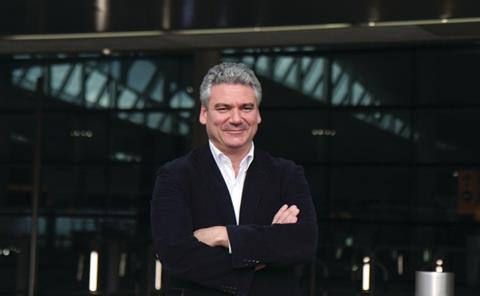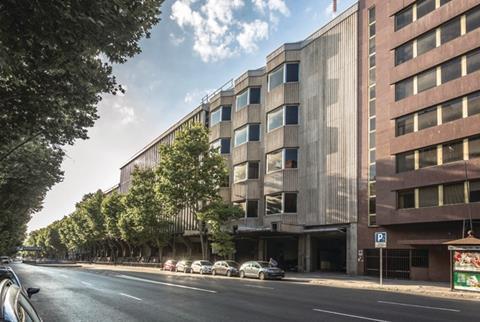With SpainŌĆÖs economy in recovery and its construction industry bouncing back, ties between Spain and the UK have been strengthening. But after the Brexit vote, will the mutually beneficial relationship continue? Iain Withers got a plane to Madrid to find out

Luis Vidal, the Spanish architect who designed Heathrow Terminal 2, was not surprised by Brexit. He spent the three days running up to polling day in London, criss-crossing the capital in black cabs. ŌĆ£I asked 15 cab drivers how they would vote and all but the last one said they would vote to exit,ŌĆØ he recalls, speaking to ║├╔½Ž╚╔·TV back at his Madrid studio on a charming tree-lined city centre street. ŌĆ£The last cabbie said: ŌĆśWell of course the others are voting to exit ŌĆō they want to punish the Conservative government because of [taxi hailing app] Uber!ŌĆÖŌĆØ His eyebrows shoot up.
ŌĆ£I said to him: ŌĆśThatŌĆÖs not what the pollŌĆÖs about!ŌĆÖ But thatŌĆÖs just a little example ŌĆō people were confused.ŌĆØ
Five months on, confusion still reigns. ItŌĆÖs not just the Brits still trying to get their heads around what ŌĆ£Brexit means BrexitŌĆØ means.
On the Continent, citizens and businesses are attempting to do the same. Spain is no different.
Madrid is a fascinating place to visit to gauge the aftershocks of the Brexit vote from a European perspective and how it has affected the perception of the UK construction sector. Spain is hardly held up as a European economic success story ŌĆō it was battered by a financial crisis, a euro crisis and a property crash. But it has more than recovered its momentum and is actually forecast to be one of EuropeŌĆÖs fastest growing economies this year. And from a construction perspective, Spain has been strengthening its ties with Britain in recent years. Alongside Luis Vidal Architects, Spanish building giants Ferrovial, Dragados and FCC and consultants including Sener are working in the UK, with a particular focus on major infrastructure programmes like HS2. Meanwhile, British consultants such as Gleeds and Arup and architect Broadway Malyan are big in Spain.
Brexit throws up challenges as well as opportunities for Spanish construction firms. Factors include the sharp drop in the value of sterling relative to the euro, the prospect of companies relocating from the UK to cities like Madrid, and the referendumŌĆÖs ramifications for freedom of movement in Europe. VidalŌĆÖs practice for one has already begun to feel the Brexit effect ŌĆō he reveals that a major London office scheme his practice was designing for a US-Spanish multinational has been put on hold as the client considers a move to a different European city, while he says Madridistas have picked up that some UK firms have ŌĆ£immediately stoppedŌĆØ hiring architects from the rest of Europe.
So what do the Spanish and those UK companies working in Spain think of Brexit and what do they think its impact on construction professionals both in Spain and the UK is likely to be?
The Spanish view of Brexit
Reaction to Brexit in Madrid ranges from bafflement to dismay. ŌĆ£It was a surprise,ŌĆØ says Bel├®n Marquina, Madrid-based deputy managing director for Ferrovial. ŌĆ£IŌĆÖm a European and I feel European. I donŌĆÖt understand why you donŌĆÖt want to go with us? [ŌĆ”] But I respect your decision.ŌĆØ
David Johnson, GleedsŌĆÖ Madrid-based regional director for Western Europe, is more frustrated with his fellow Brits back home. He says it has raised anxieties among Brits in Spain about their ŌĆ£nationalities and freedom of movementŌĆØ, although he has a Spanish wife so he doesnŌĆÖt think his freedoms should be affected. But he adds: ŌĆ£IŌĆÖm still really disappointed. I think itŌĆÖs dreadful for Europe and even worse for the UK. Young people complain that they have been left out in the cold.ŌĆØ
Across all sectors things are looking up. ItŌĆÖs tough to think of a country that was hit for six as hard as Spain ŌĆō it has so much room to grow
David Johnson, Gleeds
Vidal is an Anglophile. He studied architecture at Greenwich University in London; he travels to the UK often on business and to see friends and he even incorporated vast ribbons of glass into the roof of Heathrow Terminal 2 in an effort to convince travellers that London is sunnier than they may have heard. Asked for his personal views on the Brexit vote, he says: ŌĆ£I was really sad and sorry it happened.ŌĆØ Inspired by his own experience training in London, Vidal says he has helped scores of young Spanish architects land jobs or placements in UK practices down the years and he regrets that this appears to have come to a stop.
Engineer Arup, which has 150 staff in Madrid, is concerned about any potential restrictions to freedom of movement. Mark Chown, ArupŌĆÖs Spain director, warns: ŌĆ£Freedom of movement is very important to a consultant like us. Mobility is part of our regional strategy. We do a lot of staff exchange and itŌĆÖs good for staff development. [Any threat to this] is one of the potential negatives of Brexit.ŌĆØ He adds: ŌĆ£By any reckoning [Brexit is] a poor choice by people in the UK. But IŌĆÖm very confident business will get around any challenges. It might just be slightly hard to do.ŌĆØ
Both Vidal and Johnson believe the UKŌĆÖs loss could be MadridŌĆÖs gain. Johnson says: ŌĆ£ThereŌĆÖs a lot of opportunity for the future. Firms will want to move out of the UK and an expensive city like London. TheyŌĆÖll be looking to set up in other parts of Europe.ŌĆØ Vidal agrees: ŌĆ£We feel weŌĆÖll get more business in Spain. We have a very good standard of living, great culture, great climate and great food. More companies will want to relocate here.ŌĆØ

On the comeback trail
UK construction firms with business interests in Spain will have to weigh up whether this optimism is enough to overcome uncertainties about operating in the region after the Brexit vote. SpainŌĆÖs construction sector has been through hell and back over the past 10 years, but there are reasons to be cheerful. After suffering more than any other European countryŌĆÖs construction sector ŌĆō industry output declined by an average of 6.4% a year in 2005-14 ŌĆō it returned to growth last year and is forecast to modestly grow by an average of 2.2% a year between now and 2030, according to Global Construction Perspectives. Also, after a 10-month political deadlock including two inconclusive general elections, Spain finally formed a minority government on Saturday under the conservative Popular Party, which is likely further to steady market nerves.
British consultants Gleeds and Broadway Malyan are among those feeling more positive about work in the country. Their Madrid offices experienced terrible lows during the recession, with both cutting almost two-thirds of staff, but both are now employing more people than at their pre-crash peak ŌĆō 75 in the case of Gleeds and 54 at Broadway Malyan.
Other international studios left the country. But we stayed and we have been rewarded now as there are fewer practices competing in the market
Jorge Ponce, Broadway Malyan
ŌĆ£The fall was dreadful,ŌĆØ GleedsŌĆÖ Johnson says of the downturn. ŌĆ£None of the people we let go deserved it. A lot of good people and firms left the industry during that time.ŌĆØ Johnson is relieved the market looks rosier today. Having stayed on in the city, Gleeds celebrated 25 years in the Spanish capital this year. ŌĆ£The mood now is generally pretty good,ŌĆØ Johnson says. ŌĆ£There are a lot of opportunities ŌĆō across all sectors things are looking up. ItŌĆÖs tough to think of a country that was hit for six as hard as Spain ŌĆō it has so much room to grow.ŌĆØ
He points to the resurgent retail, hospitality, residential, industrial and offices sectors. One project that illustrates the turnaround is advertising behemoth WPPŌĆÖs scheme to redevelop a derelict former Telef├│nica headquarters building in Madrid into a new home for its Spanish ad agencies, which British architect BDG ŌĆō owned by the advertising giant ŌĆō is working on.
Jorge Ponce, board director for Spain at Broadway Malyan, can relate to GleedsŌĆÖ experience: ŌĆ£[The recession] was a bad moment for everybody and plenty of architectural studios closed down [ŌĆ”] Other international studios left the country. But we stayed and we have been rewarded now as there are fewer practices competing in the market. We came out from the crisis with fantastic recognition so now our reputation is very good.ŌĆØ
Many Spanish firms, particularly the countryŌĆÖs builders, moved business overseas en masse during the downturn. While they now see signs of green shoots, however, some are a way off from returning their focus back home. Marquina at Ferrovial, which targeted Latin America, the US, Australia and the UK, says the contractorŌĆÖs revenue from Madrid is still 90% down on its peak, at Ōé¼100m compared with Ōé¼1bn pre-recession. She is not yet telling her Ferrovial colleagues based in the UK to return to Spain. ŌĆ£Now is not the time to come back here,ŌĆØ she says. ŌĆ£IŌĆÖm very fortunate to work for a big company,ŌĆØ she admits. ŌĆ£In some of the Spanish regions there is still no work, no tenders, even now.ŌĆØ But in Madrid she can see signs of improvement: ŌĆ£It is time to develop slowly, slowly. After a big crisis when you see a small light at the end of the tunnel you feel more positive.ŌĆØ
Future relations
Freedom of movement is very important to a consultant like us. Mobility is part of our regional strategy
Mark Chown, Arup
While the current construction growth projections in the UK and Spain may be very different, itŌĆÖs clear there are still opportunities in both construction markets, and a willingness from companies from both sides to work together. Simon Manley, British ambassador to Spain, dismisses talk of bad economic consequences from Brexit. He points to multimillion-pound capital investments made by Rolls-Royce in Spain and Spanish train manufacturer CAF back in the UK since the June referendum. He adds: ŌĆ£WeŌĆÖre working hard to maintain investment in the UK. No other country has the same appetite for foreign investment ŌĆō just look at Hinkley Point C.ŌĆØ
However, Marquina says Ferrovial executives in the lead up to the vote were predicting dire consequences for the UK if it voted for Brexit. She recalls one executive warning staff: ŌĆ£It could be like the pain in Spain. But worse.ŌĆØ Indeed, her UK colleaguesŌĆÖ initial reaction to the vote ŌĆ£was negative, they were very worriedŌĆØ. But she says, cautiously, ŌĆ£things havenŌĆÖt changedŌĆØ. She can also see the potential silver linings. ŌĆ£If your island is to be more of an island youŌĆÖll need a bigger airport,ŌĆØ she jokes, referring to the prospective expansion of Heathrow.
MarquinaŌĆÖs main concern in the immediate aftermath of the Brexit vote was for her youngest son, 23, who is bilingual and living and working in London as an economist. ŌĆ£He was worried after the vote,ŌĆØ she says. ŌĆ£But when you are young, things are more positive. Now he says he wants to stay in the UK. HeŌĆÖs talking about applying for dual nationality there.ŌĆØ With so much in flux after the referendum, itŌĆÖs easy to jump to doom-laden conclusions. But perhaps itŌĆÖs not so inevitable relations between the UK and the Continent will suffer.
From Telef├│nica to WPP: An example of madridŌĆÖs office market recovery

It is a building Madridistas love to hate. The former headquarters of Spanish telecoms giant Telef├│nica is an incongruous concrete hulk sat skulking on Calle de R├Łos Rosas in the Chamber├Ł neighbourhood of the city centre. It shot to fame in 1982 when it came under attack by separatist group Eta, who detonated six bombs packed with 170kg of explosives.
There were no casualties, but the blasts took out 20,000 lines and nearly 700,000 phones. Today the building has been empty for over a decade. Telef├│nica has long gone, bar a couple of underground floors of still-whirring telecoms equipment and a tall red and white communications mast protruding from the roof.
But the 350,000ft2 building is set to get a new lease of life thanks to Martin SorrellŌĆÖs UK-based advertising behemoth WPP, which last year agreed to move in. In a scheme designed by British architect BDG and project managed by Colliers, the structure is being redeveloped into a new home for WPPŌĆÖs Spanish ad agencies, which employ more than 3,000 people.
The project is a welcome sign of life for the cityŌĆÖs previously moribund office market. ŌĆ£The recovery in Madrid is moving forward step-by-step,ŌĆØ says Irene Guerra Gomez, the London-based Spanish project architect on the job. ŌĆ£This project is the best example of that.ŌĆØ
WPP is looking to pull off a similar trick in Madrid to its London headquarters, which took the similarly unloved and bulky 1980s-built Sea Containers House on the South Bank and turned it into an achingly hip office space for all its London ad agencies, with interiors also designed by BDG.
The Madrid scheme entails a full strip out and refurbishment of the 1970s building, adding an entirely new facade curtain wall along its 135m length and a new central core and entrance. It will use the buildingŌĆÖs impressive floor spaces, with their 5m high ceilings, and enhance its string of roof gardens and terraces to create a high quality, collaborative and social working environment.
WPP is pursuing a strategy of co-locating its ad agencies in major cities across the world.

Additional reporting by Louise Dransfield



























No comments yet